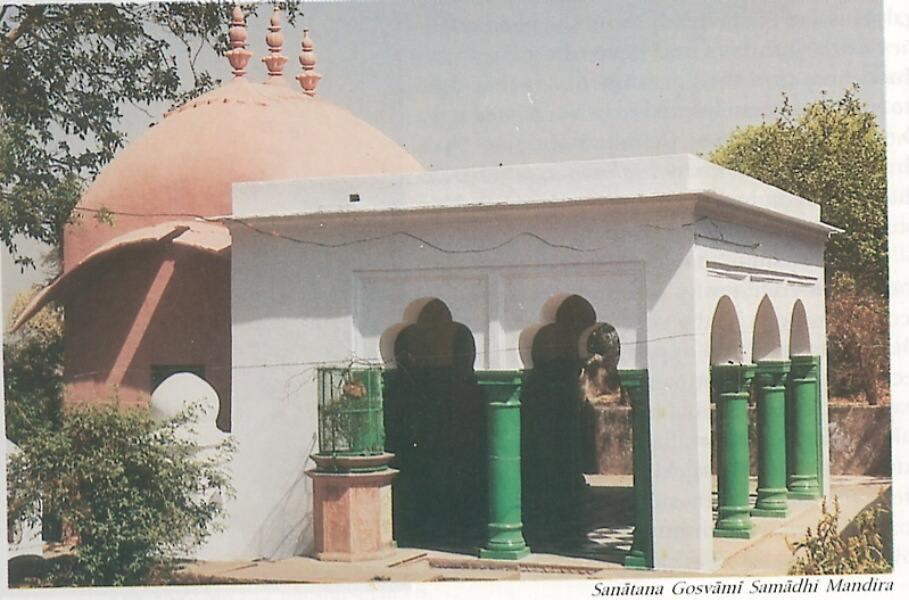
Srila Sanatana Goswami Samadhi
Vraj Mandal Parikarma – by Rajshekhar Das Brahmacari
Samadhis in Vrindavan
This samadhi area is accessible from the Vrndavanaparikramamarga, or from a road running alongside the temple.
It is located behind the original temple of Radha-MadanaMohana, and slightly down the hill.
Prasadam seva at Smadhi
Previously, the MadanaMohanapujaris used to bring maha-prasadampera (milk sweet) and a pot of water down the street to Sri SanatanaGosvami’ssamadhi. But today, “due to inconvenience,” the temple Gosvamis have asked the babajis living at the samadhi site to prepare the food, offer it to their personal Deities, and then give that maha-prasadam to Sri SanatanaGosvami.
MEMOIRS
Once on Sri SanatanaGosvami’stirobhava, Sri GauraKishoraDasaBabaji Maharaja said, “This afternoon we shall have a great festival, a tirobhavamahotsava, to honor the holy day of the passing of SrilaSanatanaGosvami.”
His servant Bihari replied, “But Babaji Maharaja, you are totally renounced and have nothing. Where will you get the things needed for a festival?”
“We don’t need anything,” explained Babaji Maharaja, “We may fast and chant the holy name of Krishna. And in this humble way, we shall enjoy a great festival.”
LIFE OF SANATANA GOSWAMI
Sri Sanatana Gosvami appeared in 1488, five years before Sri Rupa Gosvami, in a Särasvata brähmaëa family in Bengal. Sanatana and his two brothers, Rupa and Anupama, were always absorbed in bhava bhakti from early childhood. Remembering Vrndavana, they named the forests in which they played after Vraja’s twelve forests (Talavana, Madhuvana, Kamyavana, Mahavana). They called their favorite bathing ponds Radha-kunda and Syama-kunda.
Forced to submit to the ruling Muslim government, Sri Rupa and Sri Sanatana became ministers and lived at Ramakeli. But their real engagement was teaching sastras which they learned from Vidyavacaspati, brother of Sarvabhauma Bhattacarya. Pandits and brahmanas from all over India came to study under the two brothers. Sri Caitanya Mahaprabhu ordered Sri Rupa and Sanatana Gosvamis to move to Vrndavana and perform four services:
(1) Uncover Sri Krishna’s pastime places.
(2) Install Deities, arrange for Theirpuja.
(3) Compile bhakti scriptures.
(4) Propagate the rules of devotional life.
He would offer this bati (salt-free, baked bread ball) to his Deity of Madana Mohana. Giving up all kinds of material enjoyment, the Gosvamis accepted the poorest way of life as mendicants. The Radha-Madana Mohana mandir established by Sanatana Gosvami was the first one opened in Vrndavana by the six Gosvamis.
Sri Sanatana Gosvami spent forty-three years wandering from village to village in Vrndavana. The Vrajavasis would affectionately care for him treating him like their father. With patience and concern he listened to their problems. Then he would please all the villagers by his preaching and practical advice on everything from increasing crop yields to solving family quarrels.
“Renouncing all worldly pleasures, Sanatana Gosvami was humble, detached, always absorbed in study. Mahaprabhu often said that Sanatana Gosvami was His favorite devotee.
Although he was sixty-five years old, he kept his daily vow of offering 1,008 obeisances to Govardhana Hill and to any Vaisnava whom he met.
Understanding the difficulty of His pure devotee,
Presenting this to Sanatana, Krishna said, “If you circumambulate this sila everyday it will be the same as going around Govardhana Hill everyday. You will keep your vow intact and not compromise your religious principles.” Seeing that Giriraja Himself (Sri Krishna) had given the sila, Sanatana Gosvami gratefully accepted. One can still see that Govardhana sila in the Radha Damodara temple.
In the form of Labanga manjari Sanatana Gosvami serves Srimati Visakha-sakhi in Radha-Madhava’s nitya nikunja-lila. Sanatana Gosvami’s samadhi is behind Radha Madana Mohana’s temple.
Leave a comment